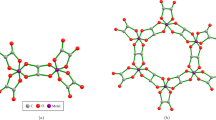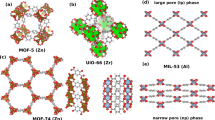Abstract
Metal–organic frameworks (MOFs) are networks of metal ions or clusters bonded by organic ligands. Their exceptional micro-porosity and vast surface area make them versatile in various applications. Despite MOFs’ extensive potential, much remains unknown regarding their properties and applications across fields. Tunable micro-porosity depends on metal and ligand combinations, but determining the optimal pairings presents challenges. We aim to identify potential optimal candidates, employing graph kernels to study organic ligand structural characteristics. This machine learning approach enhances MOF development efficiency without the need for synthesis. The atomic graph accurately represents structural features, with graph kernels assessing similarities. A unified kernel, utilizing a weighted RBF kernel, measures MOF similarity and predicts ideal metal and ligand combinations. A support vector machine classification algorithm facilitates metal similarity assessment. This method can yield high specific surface area MOFs. Experiments using data from the CoRE MOF dataset demonstrate accurate predictive model generation for six of the seven well-known graph kernels in the literature.










Similar content being viewed by others
References
Shervashidze N, Schweitzer P, Van Leeuwen EJ, Mehlhorn K, Borgwardt KM (2011) Weisfeiler-Lehman graph kernels. J Mach Learn Res 12(9):2539–2561
Hido S, Kashima H (2009) A linear-time graph kernel. In: 2009 Ninth IEEE International Conference on Data Mining, pp 179–188. https://doi.org/10.1109/ICDM.2009.30
Martino GDS, Navarin N, Sperduti A (2012) A tree-based kernel for graphs. In: SDM
Neumann M, Garnett R, Bauckhage C, Kersting K (2016) Propagation kernels: efficient graph kernels from propagated information. Mach Learn 102:209–245
Nikolentzos G, Meladianos P, Limnios S, Vazirgiannis M (2018) A degeneracy framework for graph similarity. In: IJCAI, pp 2595–2601
Sugiyama M, Borgwardt K (2015) Halting in random walk kernels. In: Advances in Neural Information Processing Systems, vol 28
Costa F, Grave KD (2010) Fast neighborhood subgraph pairwise distance kernel. In: International Conference on Machine Learning
Altintas C, Altundal OF, Keskin S, Yildirim R (2021) Machine learning meets with metal organic frameworks for gas storage and separation. J Chem Inf Model 61(5):2131–2146. https://doi.org/10.1021/acs.jcim.1c00191
Li H, Ai Z, Yang L, Zhang W, Yang Z, Peng H, Leng L (2023) Machine learning assisted predicting and engineering specific surface area and total pore volume of biochar. Bioresour Technol 369:128417. https://doi.org/10.1016/j.biortech.2022.128417
Wilmer CE, Leaf M, Lee CY, Farha OK, Hauser BG, Hupp JT, Snurr RQ (2012) Large-scale screening of hypothetical metal-organic frameworks. Nat Chem 4(2):83–89
Butler KT, Frost JM, Skelton JM, Svane KL, Walsh A (2016) Computational materials design of crystalline solids. Chem Soc Rev 45:6138–6146. https://doi.org/10.1039/C5CS00841G
Wang H, Ji Y, Li Y (2019) Simulation and design of energy materials accelerated by machine learning. Wiley Interdiscip Rev Comput Mol Sci 10:e1421
Borgwardt KM, Ong CS, Schönauer S, Vishwanathan S, Smola AJ, Kriegel H-P (2005) Protein function prediction via graph kernels. Bioinformatics 21(suppl-1):47–56
Ong SP, Richards WD, Jain A, Hautier G, Kocher M, Cholia S, Gunter D, Chevrier VL, Persson KA, Ceder G (2013) Python materials genomics (pymatgen): a robust, open-source python library for materials analysis. Comput Mater Sci 68:314–319. https://doi.org/10.1016/j.commatsci.2012.10.028
Brunauer S, Emmett PH, Teller E (1938) Adsorption of gases in multimolecular layers. J Am Chem Soc 60(2):309–319
Berg C, Christensen JPR, Ressel P (1984) Harmonic analysis on semigroups: theory of positive definite and related functions. Graduate texts in mathematics. Springer, Cham
Siglidis G, Nikolentzos G, Limnios S, Giatsidis C, Skianis K, Vazirgiannis M (2020) Grakel: a graph kernel library in python. J Mach Learn Res 21(54):1–5
Kriege NM, Johansson FD, Morris C (2020) A survey on graph kernels. Appl Netw Sci 5(1):1–42
Chung YG, Haldoupis E, Bucior BJ, Haranczyk M, Lee S, Zhang H, Vogiatzis KD, Milisavljevic M, Ling S, Camp JS, Slater B, Siepmann JI, Sholl DS, Snurr RQ (2019) Advances, updates, and analytics for the computation-ready, experimental metal-organic framework database: core mof 2019. J Chem Eng Data 64(12):5985–5998
Acknowledgements
This work was supported by JSPS KAKENHI Grant Number 21K12015.
Author information
Authors and Affiliations
Corresponding author
Additional information
Publisher's Note
Springer Nature remains neutral with regard to jurisdictional claims in published maps and institutional affiliations.
Rights and permissions
Springer Nature or its licensor (e.g. a society or other partner) holds exclusive rights to this article under a publishing agreement with the author(s) or other rightsholder(s); author self-archiving of the accepted manuscript version of this article is solely governed by the terms of such publishing agreement and applicable law.
About this article
Cite this article
Morikawa, Y., Shin, K., Kubouchi, M. et al. Prediction of specific surface area of metal–organic frameworks by graph kernels. J Supercomput 80, 13027–13047 (2024). https://doi.org/10.1007/s11227-024-05914-3
Accepted:
Published:
Issue Date:
DOI: https://doi.org/10.1007/s11227-024-05914-3




